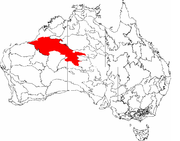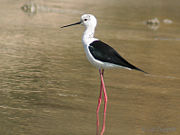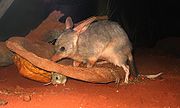
Mandora Marsh
Encyclopedia

Wetland
A wetland is an area of land whose soil is saturated with water either permanently or seasonally. Wetlands are categorised by their characteristic vegetation, which is adapted to these unique soil conditions....
system in Western Australia
Western Australia
Western Australia is a state of Australia, occupying the entire western third of the Australian continent. It is bounded by the Indian Ocean to the north and west, the Great Australian Bight and Indian Ocean to the south, the Northern Territory to the north-east and South Australia to the south-east...
close to Eighty Mile Beach, and included in the Eighty Mile Beach Ramsar Site. It lies at the western edge of the Great Sandy Desert
Great Sandy Desert
The Great Sandy Desert is a desert located in the North West of Western Australia straddling the Pilbara and southern Kimberley regions. It is the second largest desert in Australia after the Great Victoria Desert and encompasses an area of...
bioregion
Ecoregion
An ecoregion , sometimes called a bioregion, is an ecologically and geographically defined area that is smaller than an ecozone and larger than an ecosystem. Ecoregions cover relatively large areas of land or water, and contain characteristic, geographically distinct assemblages of natural...
and within the Mandora Station
Mandora Station
Mandora Station is a cattle station on the Western Australia coast south of Broome, located in the Shire of Broome. It maintains a weather station and is noted for the Mandora Marsh wetland, and for its proximity to Eighty Mile Beach, which are key stopping places for migratory birds.Mandora...
pastoral lease
Pastoral lease
A pastoral lease is Crown land that government allows to be leased, generally for the purposes of farming.-Australia:Pastoral leases exist in both Australian commonwealth law and state jurisdictions....
. The marsh is part of the 3337 km2 Mandora Marsh and Anna Plains
Anna Plains Station
Anna Plains Station is a cattle station on the Western Australian coast 250 km south of Broome. It lies in the Shire of Broome in the Kimberley region and in the Dampierland bioregion...
Important Bird Area
Important Bird Area
An Important Bird Area is an area recognized as being globally important habitat for the conservation of bird populations. Currently there are about 10,000 IBAs worldwide. The program was developed and sites are identified by BirdLife International...
, identified as such by BirdLife International
BirdLife International
BirdLife International is a global Partnership of conservation organisations that strives to conserve birds, their habitats and global biodiversity, working with people towards sustainability in the use of natural resources...
because of its importance for supporting large numbers of wader
Wader
Waders, called shorebirds in North America , are members of the order Charadriiformes, excluding the more marine web-footed seabird groups. The latter are the skuas , gulls , terns , skimmers , and auks...
s and waterbirds.
Description
Mandora Marsh has formed over thousands of years on what used to be the lower reaches and estuaryEstuary
An estuary is a partly enclosed coastal body of water with one or more rivers or streams flowing into it, and with a free connection to the open sea....
of an ancient river. The main features are two large lakes which are flooded after heavy cyclonic
Tropical cyclone
A tropical cyclone is a storm system characterized by a large low-pressure center and numerous thunderstorms that produce strong winds and heavy rain. Tropical cyclones strengthen when water evaporated from the ocean is released as the saturated air rises, resulting in condensation of water vapor...
rainfall. The westernmost Lake Walyarta 19°46′S 121°17′E is a claypan
Claypan
In geology, a claypan is a dense, compact, slowly permeable layer in the subsoil having a much higher clay content than the overlying material, from which it is separated by a sharply defined boundary. Claypans are usually hard when dry, and plastic and sticky when wet. They limit or slow the...
that extends eastwards about 30 km from the inland side of the Great Northern Highway
Great Northern Highway
The Great Northern Highway is a generally north-south Western Australian highway which links the state's capital Perth with its most northern port, Wyndham. It is in length, with being National Highway...
. Although its width may reach 5 km, the depth of water never exceeds 2 m. The eastern lake 19°47′S 121°35′E is separated from Walyarta by a calcrete ridge. It is a broad and braided drainage line containing islands of vegetation that floods extensively but soon dries out to a series of isolated salt
Salt pan (geology)
Natural salt pans are flat expanses of ground covered with salt and other minerals, usually shining white under the sun. They are found in deserts, and should not be confused with salt evaporation ponds.A salt pan is formed where water pools...
and claypans. Connecting the lakes is Salt Creek, a mangrove
Avicennia marina
Avicennia marina, commonly known as grey mangrove or white mangrove, is a species of mangrove tree classified in the plant family Acanthaceae...
-lined watercourse about 5 km long and 20 m wide. It holds permanent water and appears to be fed by a series of soaks
Soakage
A soakage, or soak, is a source of water in Australian deserts.It is called thus because the water generally seeps into the sand, and is stored below, sometimes as part of an ephemeral river or creek system.-Aboriginal water source:...
.



Salinity
Salinity is the saltiness or dissolved salt content of a body of water. It is a general term used to describe the levels of different salts such as sodium chloride, magnesium and calcium sulfates, and bicarbonates...
e wetlands Mandora Marsh includes a number of permanent or almost permanent freshwater
Freshwater
Fresh water is naturally occurring water on the Earth's surface in ice sheets, ice caps, glaciers, bogs, ponds, lakes, rivers and streams, and underground as groundwater in aquifers and underground streams. Fresh water is generally characterized by having low concentrations of dissolved salts and...
swamp
Swamp
A swamp is a wetland with some flooding of large areas of land by shallow bodies of water. A swamp generally has a large number of hammocks, or dry-land protrusions, covered by aquatic vegetation, or vegetation that tolerates periodical inundation. The two main types of swamp are "true" or swamp...
s supplied by springs along the southern side of the two main lakes. The springs are usually formed of a central, raised mound, 2-3 m high, of saturated peat
Peat
Peat is an accumulation of partially decayed vegetation matter or histosol. Peat forms in wetland bogs, moors, muskegs, pocosins, mires, and peat swamp forests. Peat is harvested as an important source of fuel in certain parts of the world...
, supporting a mixture of Melaleuca
Melaleuca
Melaleuca is a genus of plants in the myrtle family Myrtaceae known for its natural soothing and cleansing properties. There are well over 200 recognised species, most of which are endemic to Australia...
and Sesbania
Sesbania
Sesbania is a genus of flowering plants in the pea family, Fabaceae and the only genus found in Tribe Sesbanieae. Notable species include the Rattlebox , Spiny Sesbania , and Sesbania sesban, which is used in cooking...
trees, with mangroves appearing at the saline and brackish springs. The springs vary in size from 0.1 to several hectares; each spring’s mound is generally surrounded by a moat, varying from a maximum depth of 50 cm to isolated shallow pools or just wet soil. Many springs also support small stands of Cumbungi
Typha domingensis
Typha domingensis Pers., also known as Southern Cattail or Cumbungi, is a perennial herbaceous plant of genus Typha.It is found throughout temperate and tropical regions worldwide...
with the understories of some dominated by the fern
Fern
A fern is any one of a group of about 12,000 species of plants belonging to the botanical group known as Pteridophyta. Unlike mosses, they have xylem and phloem . They have stems, leaves, and roots like other vascular plants...
Achrostichum speciosum. Thickets of Saltwater Paperbark are found where flood waters remain longest; stock watering bores have been established in these thickets and the watering trough
Watering trough
A watering trough is a receptacle for the storage of water so both domestic and non-domestic livestock can obtain drinking water....
s are used by waterbirds throughout the year. The most spectacular of the springs is Mandora Soak, a raised peat bog
Bog
A bog, quagmire or mire is a wetland that accumulates acidic peat, a deposit of dead plant material—often mosses or, in Arctic climates, lichens....
estimated to be 7000 years old.
Flora and fauna
Some 269 species of vascular plantVascular plant
Vascular plants are those plants that have lignified tissues for conducting water, minerals, and photosynthetic products through the plant. Vascular plants include the clubmosses, Equisetum, ferns, gymnosperms and angiosperms...
s, from 55 families
Family (biology)
In biological classification, family is* a taxonomic rank. Other well-known ranks are life, domain, kingdom, phylum, class, order, genus, and species, with family fitting between order and genus. As for the other well-known ranks, there is the option of an immediately lower rank, indicated by the...
, have been collected from Mandora Salt Marsh. This includes 37 species from the Poaceae
Poaceae
The Poaceae is a large and nearly ubiquitous family of flowering plants. Members of this family are commonly called grasses, although the term "grass" is also applied to plants that are not in the Poaceae lineage, including the rushes and sedges...
, or true grass family, and nine introduced weeds. The most inland occurrence of mangroves in Australia is an isolated stand of Grey Mangroves
Avicennia marina
Avicennia marina, commonly known as grey mangrove or white mangrove, is a species of mangrove tree classified in the plant family Acanthaceae...
in the eastern lake of the Marsh, 60 km inland from Eighty-mile Beach. A new species of bush tomato
Bush tomato
The term bush tomato refers to the fruit or entire plants of certain nightshade species native to the more arid parts of Australia. While they are quite closely related to tomatoes , they might be even closer relatives of the eggplant , which they resemble in many details...
, Solanum oligandrum, known only from the Mandora Marsh area, was first described in 2001.
A total of 55 species of waterbirds have been seen at the marsh, of which at least 13 species have been recorded breeding there. Particularly common ones include Black-winged Stilt
Black-winged Stilt
The Black-winged Stilt or Common Stilt is a widely distributed very long-legged wader in the avocet and stilt family . Opinions differ as to whether the birds treated under the scientific name H. himantopus ought to be treated as a single species and if not, how many species to recognize...
, Whiskered Tern
Whiskered Tern
The Whiskered Tern is a seabird of the tern family Sternidae. This bird has a number of geographical races, differing mainly in size and minor plumage details....
, Grey Teal
Grey Teal
The Grey Teal, Anas gracilis is a dabbling duck found in open wetlands in New Guinea, Australia, New Zealand, Vanuatu and Solomon Islands....
, White-necked Heron
White-necked Heron
The White-necked Heron, Ardea pacifica also known as the Pacific Heron is found throughout New Guinea and Australia, except for the most arid regions, and is a vagrant to New Zealand....
, and Great Egret
Great Egret
The Great Egret , also known as the Great White Egret or Common Egret, White Heron, or Great White Heron, is a large, widely-distributed egret. Distributed across most of the tropical and warmer temperate regions of the world, in southern Europe it is rather localized...
. Australian Pelican
Australian Pelican
The Australian Pelican is a large water bird, widespread on the inland and coastal waters of Australia and New Guinea, also in Fiji, parts of Indonesia and as a vagrant to New Zealand.-Taxonomy:...
s and Black Swan
Black Swan
The Black Swan is a large waterbird, a species of swan, which breeds mainly in the southeast and southwest regions of Australia. The species was hunted to extinction in New Zealand, but later reintroduced. Within Australia they are nomadic, with erratic migration patterns dependent upon climatic...
s breed there in large numbers when floods make conditions suitable.
The threatened Bilby
Bilby
Bilbies are desert-dwelling marsupial omnivores; they are members of the order Peramelemorphia. Before European colonisation of Australia, there were two species. One became extinct in the 1950s; the other survives but remains endangered....
, which is specially protected by the Commonwealth
Government of Australia
The Commonwealth of Australia is a federal constitutional monarchy under a parliamentary democracy. The Commonwealth of Australia was formed in 1901 as a result of an agreement among six self-governing British colonies, which became the six states...
Environment Protection and Biodiversity Conservation Act 1999
Environment Protection and Biodiversity Conservation Act 1999
The Environment Protection and Biodiversity Conservation Act 1999 is an Act of the Parliament of Australia that provides a framework for protection of the Australian environment, including its biodiversity and its natural and culturally significant places...
, has been recorded in sandy sites within the Marsh. Altogether, 22 species of mammal
Mammal
Mammals are members of a class of air-breathing vertebrate animals characterised by the possession of endothermy, hair, three middle ear bones, and mammary glands functional in mothers with young...
, 49 reptile
Reptile
Reptiles are members of a class of air-breathing, ectothermic vertebrates which are characterized by laying shelled eggs , and having skin covered in scales and/or scutes. They are tetrapods, either having four limbs or being descended from four-limbed ancestors...
s and six frog
Frog
Frogs are amphibians in the order Anura , formerly referred to as Salientia . Most frogs are characterized by a short body, webbed digits , protruding eyes and the absence of a tail...
s have been recorded there, while a new goby
Goby
The gobies form the family Gobiidae, which is one of the largest families of fish, with more than 2,000 species in more than 200 genera. Most are relatively small, typically less than 10 cm in length...
species has been discovered in Salt Creek.
Conservation
Cattle grazingGrazing
Grazing generally describes a type of feeding, in which a herbivore feeds on plants , and also on other multicellular autotrophs...
has caused substantial deterioration in the vegetation and physical environment of the springs and Salt Creek; Saunders Spring in 1997, and Grants Spring in 2001, were fenced to limit further damage. High numbers of feral camels
Australian feral camel
Thousands of the two main species of Australian feral camels, mostly dromedaries but also some bactrian camels, were imported into Australia during the 19th century for transport and construction as part of the colonisation of the central and western parts of Australia. Motorised transport replaced...
and cats
Feral cat
A feral cat is a descendant of a domesticated cat that has returned to the wild. It is distinguished from a stray cat, which is a pet cat that has been lost or abandoned, while feral cats are born in the wild; the offspring of a stray cat can be considered feral if born in the wild.In many parts of...
are present in the Marsh.

